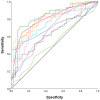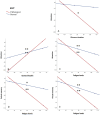Understanding the olfactory role in post-COVID cognitive and neuropsychiatric manifestations
- PMID: 38860043
- PMCID: PMC11164098
- DOI: 10.3389/fpsyg.2024.1407887
Understanding the olfactory role in post-COVID cognitive and neuropsychiatric manifestations
Abstract
Introduction: Olfactory dysfunction (OD) is frequent after SARS-CoV-2 infection. The aim of this study was to examine if long-term OD is common in post-COVID condition, and the relationship between olfaction, cognition, neuropsychiatric symptoms, and disease duration in these patients.
Methods: This study included 121 participants with post-COVID condition and 51 healthy controls (HC). A comprehensive neuropsychological and neuropsychiatric assessment was conducted, encompassing various domains, including general cognition, processing speed, verbal fluency, attention, verbal memory, visual memory, visuoconstructive ability, visuospatial ability, abstraction, executive functions, anxious-depressive symptoms, general health perception, fatigue level, sleep quality, and olfaction. Statistical analyses were carried out to understand the relationship of OD with cognition, and its role as moderator variable.
Results: In total, 25% of the post-covid patients had a reduced smell capacity, while only 9.3% of HC presented OD. Post-COVID patients had statistically significantly worse cognitive performance and clinical status than HC. Verbal fluency (AUC = 0.85, p < 0.001), and attention (AUC = 0.82, p < 0.001) were the variables that best discriminate between groups. OD seemed to be a moderator between fatigue and cognition, and between disease duration and attention (β = -0.04; p = 0.014).
Discussion: The study highlights marked cognitive and neuropsychiatric sequelae in individuals post-COVID relative to HC. Olfactory impairment exhibits correlations with both cognitive performance and general health. Olfaction emerges as a potential prognostic marker owing to its moderating influence on disease severity indicators.
Keywords: cognition; neuropsychiatry; neuropsychology; olfaction; post-covid condition.
Copyright © 2024 Azcue, Del Pino, Saenz de Argandoña, Ortiz de Echevarría, Acera, Fernández-Valle, Ayo-Mentxakatorre, Lafuente, Ruiz-Lopez, López de Munain, Gabilondo, Gómez-Esteban and Tijero-Merino.
Conflict of interest statement
The authors declare that the research was conducted in the absence of any commercial or financial relationships that could be construed as a potential conflict of interest.
Figures





Similar articles
-
Cognitive and functional connectivity impairment in post-COVID-19 olfactory dysfunction.Neuroimage Clin. 2023;38:103410. doi: 10.1016/j.nicl.2023.103410. Epub 2023 Apr 17. Neuroimage Clin. 2023. PMID: 37104928 Free PMC article.
-
Brain fog of post-COVID-19 condition and Chronic Fatigue Syndrome, same medical disorder?J Transl Med. 2022 Dec 6;20(1):569. doi: 10.1186/s12967-022-03764-2. J Transl Med. 2022. PMID: 36474290 Free PMC article.
-
Post-COVID-19 fatigue: the contribution of cognitive and neuropsychiatric symptoms.J Neurol. 2022 Aug;269(8):3990-3999. doi: 10.1007/s00415-022-11141-8. Epub 2022 Apr 30. J Neurol. 2022. PMID: 35488918 Free PMC article.
-
Olfactory training for olfactory dysfunction in COVID-19: A promising mitigation amidst looming neurocognitive sequelae of the pandemic.Clin Exp Pharmacol Physiol. 2022 Apr;49(4):462-473. doi: 10.1111/1440-1681.13626. Epub 2022 Feb 10. Clin Exp Pharmacol Physiol. 2022. PMID: 35090056 Review.
-
Mechanism and treatment of olfactory dysfunction caused by coronavirus disease 2019.J Transl Med. 2023 Nov 17;21(1):829. doi: 10.1186/s12967-023-04719-x. J Transl Med. 2023. PMID: 37978386 Free PMC article. Review.
Cited by
-
Depression, Anxiety, and Neuropsychiatric Symptom Burden in a Longitudinal Cohort with Persistent Psychophysical Post-COVID Olfactory Dysfunction.Brain Sci. 2024 Dec 19;14(12):1277. doi: 10.3390/brainsci14121277. Brain Sci. 2024. PMID: 39766476 Free PMC article.
References
-
- Araújo L., Arata V., Figueiredo R. G. (2021). Olfactory disorders in post-acute COVID-19 syndrome. Dermatol. Sin. 5, 116–122. doi: 10.3390/sinusitis5020012 - DOI
-
- Boscolo-Rizzo P., Guida F., Polesel J., Marcuzzo A. V., Antonucci P., Capriotti V., et al. . (2022). Self-reported smell and taste recovery in coronavirus disease 2019 patients: a one-year prospective study. Eur. Arch. Otorrinolaringol. 279, 515–520. doi: 10.1007/s00405-021-06839-w, PMID: - DOI - PMC - PubMed
LinkOut - more resources
Full Text Sources
Miscellaneous

